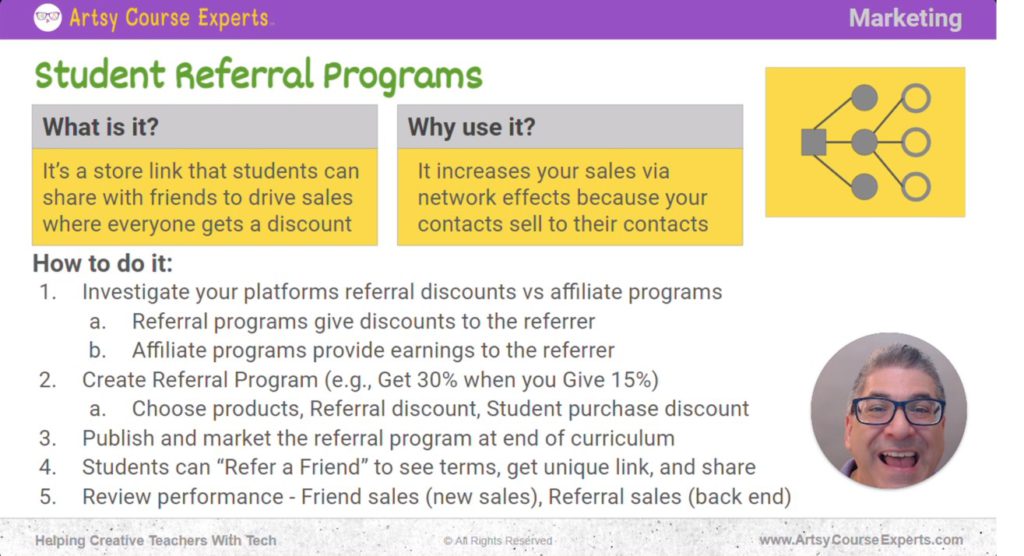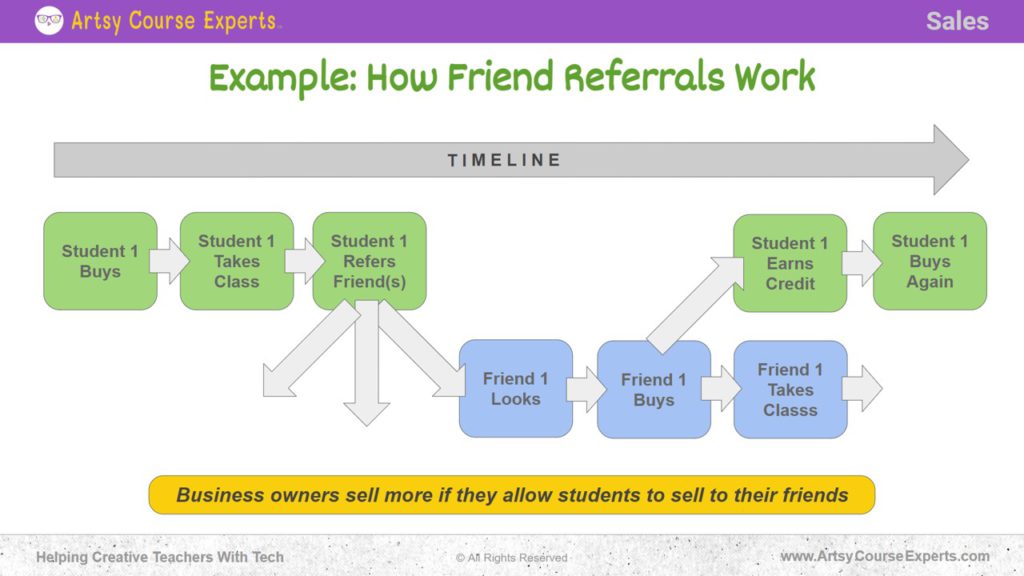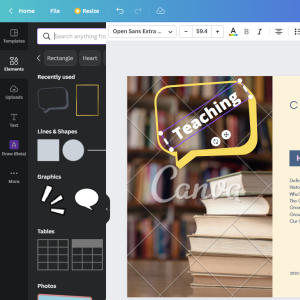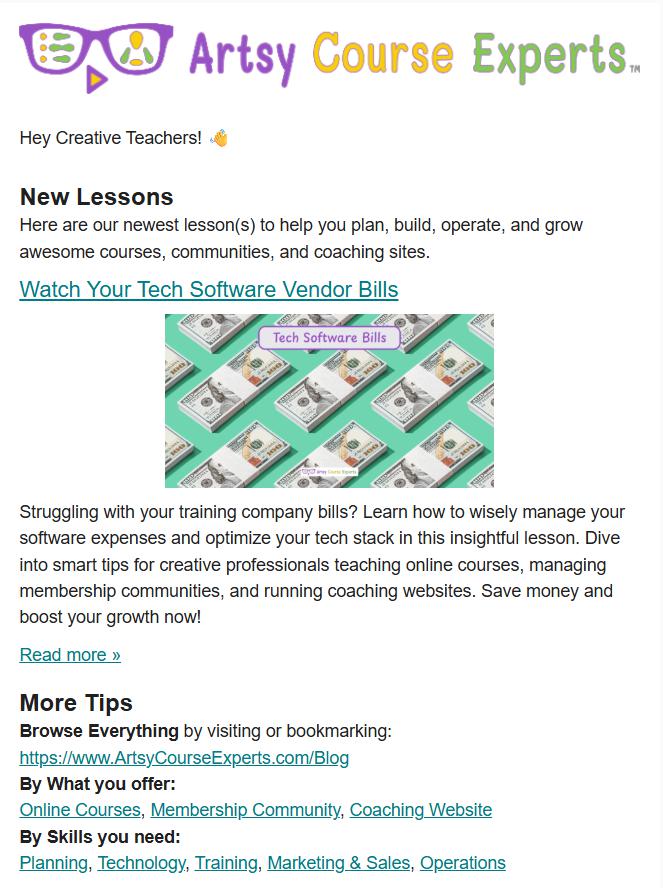Introduction
In the fast-paced world of e-learning, where competition is fierce, finding effective ways to attract and retain students is crucial. A student referral program is a powerful strategy that boosts the interest and satisfaction of your current students while driving business revenues.
In this lesson, we’ll go over student referral programs specifically designed for online courses, however they could also be used for communities and coaching. We’ll learn about student referral programs so that you can turn your current students into your future sales force.
Challenges Training Businesses Can Face If They Don’t Use Student Referral Programs:
- Difficulty in expanding the student base with new students.
- Higher acquisition costs and reliance on paid ads.
- Spending more time creating free content in order to attract organic customers through Search.
- Decreased student engagement and sense of community, leading to students/members leaving.
- Difficulty establishing credibility without a solid recommendation from prior happy customers.
Video Lesson – How To Use Student Referrals To Grow Your Online Education Business
Who Can Use Student Referral Programs
Almost any kind of teacher, professional, or coach can use student referral programs to grow their customer base and revenues.
Here are some examples of how teachers teaching creative skills in the arts can use referral programs:
- Grow your online course sales by having successful students make suggestions to their peers
- Grow your paid community by having your members make referrals to their friends
- Grow your coaching business by having your students make recommendations to other students
This can work for a wide range of educational businesses like teaching painting, 3D printing, quilting, writing children’s books, magic, and set design.
What Are Student Referral Programs?
A student referral program is a URL link that students can share with their friends to help drive your sales by offering them a discounted price and then the referrer student receives credit to buy more from you at a later time.
They can choose to share it with just a few select friends or widely to many friends and connections through platforms like Facebook, Twitter, and Pinterest. These links can be shared with a short note that you provide the service or a personalized message from the referrer. Remember these are prior students so they can add what they liked and got out of your prior service like online course.
When the referral friend joins your course, community, or coaching program using that URL, they also get a discount to motivate them to buy instantly.
The referrer also earns credits or discounts towards future courses with you, which they would otherwise have to pay full price for. This way, both the referrer and the friend benefit.
Why Use Student Referral Programs?
You may want to use referral programs because it increases sales through network effects. Your students sell to their friends and contacts, allowing you to reach more students and multiply your impact.
Additionally, it increases repeat buyers as your previous students earn points or credits to purchase a course, membership, or other service from you in the future.
If you have a small number of students that have made it into your program through organic, social, or paid ads, they can continuously add additional leads to your program. By leveraging student referral programs, you can save money on finding leads and content generation.

How to Guide For Referrals
Investigate Your Platforms
On your platform, you need to review and investigate if they have referral discount programs versus affiliate programs. Sometimes these features are built right into the native platform, or you may have to use external tools or websites with affiliate programs such as Commission Junction, Awin, or AffiliateWP. Alternatively, you might have to use plugins on WordPress.
Many referral programs are native to your platform and built right into systems like Thinkific and Kajabi. It’s great because they just work automatically.
Let’s quickly review the difference between a referral program and an affiliate program.
Referral Programs Give Discounts to the Referrer
A referral program gives discounts to the referrer. You have a student, and that student may become a referrer. If that referrer gets one of their friends to sign up, then they would earn points or a discount towards a future purchase. As the business owner, you get a new customer and get an old customer to consume more.
Affiliate Programs Provide Earnings to the Referrer
However, an affiliate program provides earnings with or without requiring the referrer to be a student. That’s up to you as a business owner. You may choose to require your affiliates to go through your program first so that they can recommend something and have firsthand experience. An affiliate would earn money every time somebody buys through their personalized affiliate links.
To summarize, a referral program gives referrers a discount or money towards future purchases, allowing your students to buy more items. On the other hand, an affiliate program allows third parties to earn actual money every time somebody buys your course or community.
Create Referral Program (e.g.. Get 30% When You Give 15%)
You probably have to create a referral program. Even though your platform has it, it’s not always on or enabled by default. You may want to create a referral program like getting 30% off when you give a 15% discount to anybody who buys.
Choose Products, Referral Discount, Student Purchase Discount
When you create a referral program, you’re also going to have to choose which products are included in this referral program. You may want to enable everything, or you may want to pick and choose one or two of the courses, but not all of your courses or your main course and your community. It’s up to you. Some people may only choose the courses that need more sales help. You’re going to want to configure the referral program with the exact products and services that will be enabled for referrals.
You will also need to specify the referral discount, which is the amount the referrer will receive in credit towards a future program from you. Often if they get 25% credit on a $100 product, they will earn a $25 discount that can be applied to one of your other programs.
Then, you’re going to choose the discount that future students will receive. So, if a referrer finds their friend and their friend then goes ahead and joins your course, you’ll have to decide what discount their friend will receive when buying your course.
Market the Referral Program Information
This involves creating a headline and a body to explain what it is. Basically, you are letting your students know that this opportunity exists, and you want them to see it and act on it by using a catchy title, hook line, and brief summary of what it is and why they should join.
You’re going to want to place it somewhere visible to your students or members. For example, you can include it at the end of your course. So that after a student completes the course, they might see a message like, “Hey, would you like to join our refer-a-friend program and let your friends know about this course? If they find it helpful, they will get a discount, and you will earn credits that you can use to purchase other courses.”
Publish the Referral Program
Once you have your referral plan figured out you’ll want to actually publish and enable the program. This means that you have entered all the referral program settings required. Of course the exact program settings will vary a little bit across the many different platforms.
Here are some the referral program settings that you’ll want to set:
- Name
- Description
- Promotional Picture
- Custom Links
- Products
- Discounts for the student
- Discounts for the student’s friends
- Some global on/off setting
From here on the referral program is live and fully enabled!
Students Can View “Refer a Friend” Info Page
Once your students decide to join the “Refer a Friend” program, they should go to a program information page that displays the program’s name and info.
It shows the terms, including how much of a discount they would get, and how much of a discount their friends would get, and even provides a unique URL that your students can use to share with their friends.
This page often has a view to show how many friends actually purchased and how many credits the referrer has earned so that they can buy more services from you.
Refers can come here anytime they want info on your student referral program or their status. You may want to remind them about this page or link with a short cheat sheet, annual email, or video.

Review Program Performance
Finally, as a business owner, you’re going to want to review your “Refer a Friend” program performance. You’ll want to know how many new sales occurred because of friends that your referrers found, how many of those friends signed up, and how many new sales happened due to networking and referrals.
Additionally, you’ll want to assess how many referrers used their earned credits to purchase additional products and services from you. You may want to offer loyalty benefits to students the are repeat buyers, such as a special chat room, shout outs in public, or early access to new programs.

Example – How Friend Referrals Work For A Creative Business Teacher
Let’s talk about a creative professional and business owner that has a course and is setting up a Refer a Friend program. In this example, we’ll walk through the entire process using Student 1 and how Friend 1 became interested.
Student 1 Buys
First of all, a student discovers you, probably through a web search, YouTube, or a paid ad. They find you and your course information, clicks into your sales page details, and ultimately makes a purchase. This first student who buys from you will become the referrer later.
Student 1 Takes Class
The first student takes the class over a few weeks and eventually completes it. They might also be navigating through and selecting specific sections or lessons. Regardless, they reach the end and notice an opportunity to refer a friend. They might earn some credits to purchase another course they were interested in.
For instance, they might have bought a Photoshop course but have a strong desire to learn Illustrator. By referring friends, they can potentially earn credits towards that goal and get it for free or low cost with discounts.
Eventually, Student 1 completes the course, learns some stuff, likes your style, and was interested in the referral program.
Student 1 Refers Friend(s)
They see this opportunity to refer a friend to earn some credit towards future courses and they do it, they click on it, they see the terms, and they get this URL that they can use.
So Student 1 goes and sends it to a few friends and posts it on their social media, inviting friends to take a look at an interesting course he took on Photoshop. He also lets everyone know that the teacher was cool and that the course rocks.
Student 1 tells his friends that if anybody buys the course using the link they get an automatic 20% off coupon.
Friend 1 Looks
After Student 1 posts, a friend called Friend 1 looks and says, “Oh, I need that and its time to learn some new design skills.”
Friend 1 clicks on the link which then shows the Photoshop course information. Behind the scenes the systems start logging that Student 1 had a friend view the sales page, but did not buy just yet.
Friend 1 continues to look at the sales page information like Overview, Teacher Bio, Curriculum, Testimonials, etc. Plus she remembers that her friend Student 1 said good things and she trusts him.
Friend 1 Buys
Then friend 1 goes ahead and buys it. The view sales page had a link with Refer a friend information, the sales system starts it’s process.
Friend 1 automatically sees a Discount applied at check out and ultimately buys it. She starts learning advanced Photoshop skills.
The Teacher gets all the usual notification emails and sees that a new purchase was made. In addition, the business owner sees that not only was a sale made, but the referrer earned some credit, so there is a good chance of selling another course at a discount to the Student 1.
Student 1 Earns Credit
Since Student 1 sent Friend 1, they get credit for the referral.
They may earn a percentage of the value of that first course as credit. For example, from this transaction Student 1 may have earned $50 in credit towards a future course.
Over time, a few other friends may also utilize that “refer a friend” link, earning Student 1 up to 75% or 100% the cost of a future course.
Student 1 Buys Again
Student 1 now has earned enough credits that they can cover 75% of their next course.
They can choose to keep sending friends to earn more credits, even if it takes a little while to eventually earn 100% or more.
But in this example, Student 1 decides to buy another course now, perhaps the Illustrator course. So they view the course information page and click buy. Since they have earned credits, the course price is reduced like a coupon and they get to buy their next premium course at a discount.
Instead of paying a hundred percent, they only pay 25% because they have 75% of that course covered in referral credits.
Friend 1 Takes The Class And May Also Refer
The process continues with Friend 1. After Friend 1 takes a class, they might also refer some people. Not everybody would spend the energy to share and earn coupons, but many people do.
Wrap Up
This Referral Program benefits creative business owners who offer courses, have a community, or provide coaching services.
A portion of your customers will likely refer a friend, which will drive additional students to your business.
It will also encourage repeat buyers as those initial students enroll in more courses.
Finally, this can drastically reduce your business marketing and advertising costs.
Frequently Asked Questions About Student Referral Programs

Summary – Student Referral Programs
Student referral programs offer a powerful tool for online training businesses to extend their reach, drive new revenues, and reduce marketing costs.
These programs not only attract new customers but also increase repeat buyers and enhance the lifetime of engaged customers.
Referral programs can be used by creative professionals on courses, communities, coaching, e-books, and more. You can also use referral rewards to move students from courses to communities or from single payments to recurring payments.
Once you’ve reached a first wave of students with traditional sales, and allowing your students to recommend and sell to their friends, you can effectively automate the sales machine for your business.
Tips for using student referral programs:
- Review your platform to check if referrals or affiliates are available
- Think about how much money you spend today to acquire a new customer (Cost of Acquisition)
- Could you offer a discount to existing students that is less than the cost to acquire a new customer
- Which of your products would be most ideal for a referral program
- What discount could you offer friends year round to motivate them to buy when a trusted friend refers
- Where are all the places you can mention your referral program – like email, end of course, community
- Simply your referral program name and description so its crystal clear and makes benefits obvious
- Mark your calendar to do monthly program performance reviews to tweak your settings or strategy
You should be a little smarter now. Thanks for hanging out!
Please subscribe to get more tips for creative online course teachers.
More Tips For Online Teachers
These lessons can also help you with Sales and Technology:
- AIDA Model For Training Businesses
- Understanding Your Ideal Target Audience For Online Course Teachers
- A/B Testing for Creative Course Teachers
- Using Live Webinars for Your Course
- Analyzing E-learning Checkout Process










